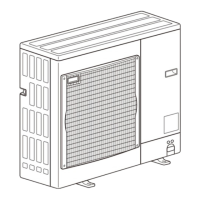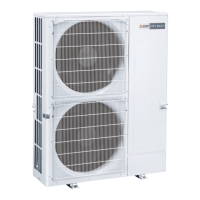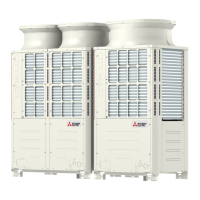122
11. Removing the bypass valve
(1)Removetheservicepanel.(SeeFigure1)
(2)Removethetoppanel.(SeeFigure1)
(3)Removetheelectricalpartsbox.(SeePhoto3)
(4)Remove3rightsidepanelfixingscrews(5×12)inthe
rearoftheunitandremovetherightsidepanel.
(5)Removethebypassvalvecoil.(SeePhoto8).
(6)Recoverrefrigerant.
(7)Removetheweldedpartofbypassvalve.
Note 1: Recover refrigerant without spreading it in the air.
Note 2: The welded part can be removed easily by
removing the right side panel.
13. Removing the reactor (ACL) (A24)
(1)Removetheservicepanel.(SeeFigure1)
(2)Removethetoppanel.(SeeFigure1)
(3)Removetheelectricalpartsbox.(SeePhoto3)
(4)Remove3reactorfixingscrews(4×16)andremovethe
reactor.
Note:Thereactorisattachedtotherearoftheelectricalpartsbox
.
Photo 10
Reactorfixingscrew
12. Removing the high pressure switch (63H)
(1)Removetheservicepanel.(SeeFigure1)
(2)Removethetoppanel.(SeeFigure1)
(3)Removetheelectricalpartsbox.(SeePhoto3)
(4)Remove3rightsidepanelfixingscrews(5×12)inthe
rearoftheunitandremovetherightsidepanel.
(5)Pullouttheleadwireofhighpressureswitch.
(6)Recoverrefrigerant.
(7)Removetheweldedpartofhighpressureswitch.
Note 1: Recover refrigerant without spreading it in the air.
Note 2: The welded part can be removed easily by
removing the right side panel.
Note 3: When installing the high pressure switch, cover it
with a wet cloth to prevent it from heating (210˚F
or more), then braze the pipes so that the inside
of pipes are not oxidized.
Bypassvalve
Bypassvalve
fixingscrew
Reactorfixingscrews
Reactor
(ACL)
Photo 11
Photo 12
Electricalpartsbox
Highpressure
switch(63H)
Bypassvalvecoil
Linearexpansion
valvecoil(LEV-A)
4-wayvalve
OPERATING PROCEDURE
PHOTOS

